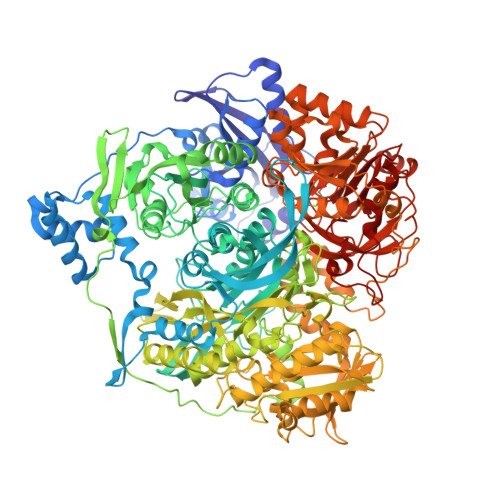Formylglycinamide ribonucleotide amidotransferase from Salmonella typhimurium: role of ATP complexation and the glutaminase domain in catalytic coupling
Tanwar, A.S., Morar, M., Panjikar, S., Anand, R.(2012) Acta Crystallogr D Biol Crystallogr 68: 627-636
- PubMed: 22683785
- DOI: https://doi.org/10.1107/S0907444912006543
- Primary Citation of Related Structures:
3UGJ, 3UJN, 3UMM - PubMed Abstract:
Formylglycinamide ribonucleotide (FGAR) amidotransferase (FGAR-AT) takes part in purine biosynthesis and is a multidomain enzyme with multiple spatially separated active sites. FGAR-AT contains a glutaminase domain that is responsible for the generation of ammonia from glutamine. Ammonia is then transferred via a channel to a second active site located in the synthetase domain and utilized to convert FGAR to formylglycinamidine ribonucleotide (FGAM) in an adenosine triphosphate (ATP) dependent reaction. In some ammonia-channelling enzymes ligand binding triggers interdomain signalling between the two diverse active centres and also assists in formation of the ammonia channel. Previously, the structure of FGAR-AT from Salmonella typhimurium containing a glutamyl thioester intermediate covalently bound in the glutaminase active site was determined. In this work, the roles played by various ligands of FGAR-AT in inducing catalytic coupling are investigated. Structures of FGAR-AT from S. typhimurium were determined in two different states: the unliganded form and the binary complex with an ATP analogue in the presence of the glutamyl thioester intermediate. The structures were compared in order to decipher the roles of these two states in interdomain communication. Using a process of elimination, the results indicated that binding of FGAR is most likely to be the major mechanism by which catalytic coupling occurs. This is because conformational changes do not occur either upon formation of the glutamyl thioester intermediate or upon subsequent ATP complexation. A model of the FGAR-bound form of the enzyme suggested that the loop in the synthetase domain may be responsible for initiating catalytic coupling via its interaction with the N-terminal domain.
Organizational Affiliation:
Department of Chemistry, Indian Institute of Technology, IIT-Bombay, Mumbai 400 076, India.





















